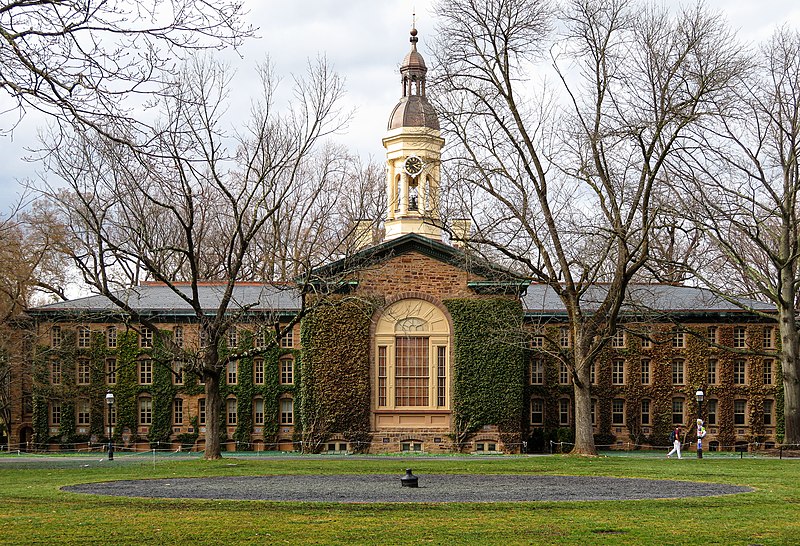English: Buried in the ground at the center of the lawn south of Nassau Hall is the "Big Cannon," which was left in Princeton by British troops as they fled following the Battle of Princeton. It remained in Princeton until the War of 1812, when it was taken to New Brunswick. In 1836 the cannon was returned to Princeton and placed at the eastern end of town. It was removed to the campus under cover of night by Princeton students in 1838 and buried in its current location in 1840.
A second "Little Cannon" is buried in the lawn in front of nearby Whig Hall. This cannon, which may also have been captured in the Battle of Princeton, was stolen by students of Rutgers University in 1875. The theft ignited the Rutgers-Princeton Cannon War. A compromise between the presidents of Princeton and Rutgers ended the war and forced the return of the Little Cannon to Princeton. The protruding cannons are occasionally painted scarlet by Rutgers students who continue the traditional dispute.
In years when the Princeton football team beats the teams of both Harvard University and Yale University in the same season, Princeton celebrates with a bonfire on Cannon Green. This occurred in 2012, ending a five-year drought. The next bonfire happened on November 24, 2013, and was broadcast live over the Internet.
en.wiki.x.io/wiki/Princeton_University#Cannon_Green
Nassau Hall (or colloquially Old Nassau) is the oldest building at Princeton University in Princeton, Mercer County, New Jersey, United States. Additionally, it briefly served as the United States Capitol building. At the time it was built in 1756, Nassau Hall was the largest building in colonial New Jersey and the largest academic building in the American colonies.
The university, originally known as the College of New Jersey, held classes for one year in Elizabeth and nine years in Newark before the hall was completed in 1756. Designed originally by Robert Smith, the building was subsequently remodeled by notable American architects Benjamin Latrobe and John Notman. In the early years of Princeton University, Nassau Hall accommodated classrooms, a library, a chapel, and residential space for students and faculty. It housed the university's first Department of Psychology, for example.
During the American Revolutionary War, Nassau Hall was possessed by both British and American forces and suffered considerable damage, especially during the Battle of Princeton on January 3, 1777. From June 30 to November 4, 1783, Princeton was the provisional capital of the United States, and Nassau Hall served as its seat of government. The Congress of the Confederation met in the building's library on the second floor. According to Princeton University, "Here Congress congratulated George Washington on his successful termination of the war, received the news of the signing of the definitive treaty of peace with Great Britain, and welcomed the first foreign minister—from the Netherlands—accredited to the United States."
At present, Nassau Hall houses Princeton University's administrative offices, including that of the university's president. Old Nassau refers affectionately to the building and serves as a metonym for the university as a whole. The U.S. Department of the Interior designated Nassau Hall a National Historic Landmark in 1960, "signifying its importance in the Revolutionary War and in the history of the United States."
When the building was constructed in 1754, the college's board wanted to name it after Jonathan Belcher, the chosen royal governor of New Jersey, but he graciously declined, preferring it to be dedicated "to the immortal memory of the glorious King William III," who hailed from the Dutch House of Orange-Nassau. As a result, the building is known as Nassau Hall.
The New Jersey Legislature met for the first time in Nassau Hall on August 27, 1776.
The British Redcoats seized control of Nassau Hall in 1776, and American soldiers were forced to fire upon their own building in the Battle of Princeton on January 3, 1777. Three cannonballs were fired, but only two made contact. One glanced off the south side of the building; the damage can still be seen today. Another cannonball flew through a window in the Faculty Room and "decapitated" King George's portrait. The cannonball was said to have come from a gun in the artillery company commanded by Alexander Hamilton, who had been rejected by Princeton when he first came to the colonies. The result of the battle was a decisive Patriot victory, and Nassau Hall was retaken by the Americans.
The Congress of the Confederation convened in Nassau Hall for a little more than four months (from June 30, 1783, to November 4, 1783). The normal location in Philadelphia, Pennsylvania had to be vacated because of a mutiny by Continental Army soldiers.
Starting in 1869, each graduation class adds a new sprig of ivy to grow up the walls of the building.
The first U.S. commemorative postage stamp printed on colored paper honored Nassau Hall on its bicentennial. It depicted a front view of Nassau Hall. It was denominated at the first class rate of 3 cents and was on orange paper. It was first issued at Princeton, New Jersey, on September 22, 1956.
en.wiki.x.io/wiki/Nassau_Hall
en.wiki.x.io/wiki/Wikipedia:Text_of_Creative_Commons_...


